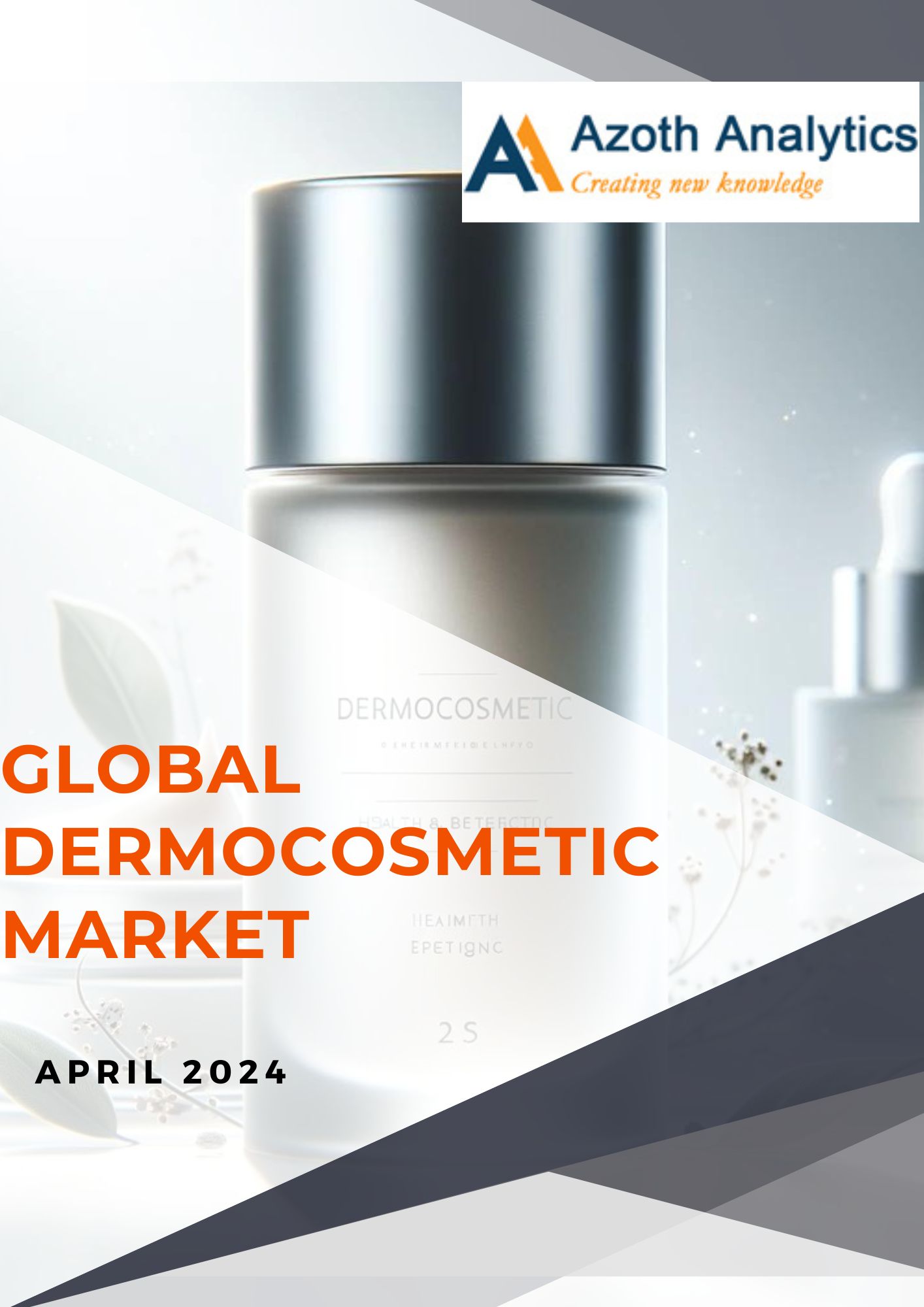
Global Dermocosmetic Market (2024 Edition): Analysis By Type (Skin Care, Hair Care), By Distribution Channel, By End-Users, By Region: Market Insights and Forecast (2020-2030)
- USD
Licensing options

Licensing options
Executive Summary
Azoth Analytics has released a research report titled “Global Dermocosmetic Market (2024 Edition)” which provides a complete analysis of the Global Dermocosmetic industry in terms of market segmentation By Type (Skin Care, Hair Care), By Distribution Channel (Supermarkets & Hypermarkets, Pharmacy and Drug Store, Online, Others), By End-Users (Dermatology Clinics, Spas and Salons, At-Home, Hospitals) for the historical period of 2020-2023, the estimates of 2024 and the forecast period of 2025-2030.
The report analyses the Dermocosmetic Market by Region (Americas, Europe, Asia Pacific, Middle East & Africa) and 10 Countries (United States, Canada, United Kingdom, Germany, France, Italy, Spain, China, Japan, South Korea). The Global Dermocosmetic market showcased growth at a CAGR of 4.18% during 2020-2023. The market was valued at USD 67.42 Billion in 2023 which is expected to reach USD 108.94 Billion in 2030. The market for dermocosmetics has been growing rapidly in recent years, driven by increasing consumer awareness of skincare and beauty, advancements in skincare technology, and a growing aging population seeking anti-aging solutions.
According to epidemiologic studies, out of every 10 people, one will have eczema sometime in their life more likely to develop the condition as a child, around 9.6 million kids under the age of 18 in the U.S. have eczema. A third of these children have moderate to very bad forms of the condition. The rising incidence of skin disorders such as acne, eczema, psoriasis, rosacea, and hyperpigmentation contributes to the demand for dermatologist-recommended dermocosmetic products. Consumers seek effective solutions to manage and alleviate symptoms associated with these conditions. The growing prevalence of skin disorders expands the addressable market for dermocosmetics tailored to treat specific dermatological concerns. Brands that offer clinically proven solutions for common skin conditions gain consumer trust and loyalty, driving market growth in this segment.
Urbanization brings about higher levels of pollution, including air pollution, UV radiation, heavy metals, and particulate matter. These environmental stressors have detrimental effects on the skin, leading to issues such as premature aging, dullness, dehydration, and exacerbation of skin conditions like acne and eczema. As urban populations are increasingly exposed to these pollutants, there is a growing demand for skincare products that offer protection against environmental aggressors and help repair and strengthen the skin barrier.
Bioengineering and biotechnology techniques involve the use of living organisms or biological processes to produce skincare ingredients or develop novel formulations. This includes techniques such as fermentation, genetic engineering, and cell culture technology. Bioengineered and biotechnologically derived ingredients offer several benefits, including enhanced purity, stability, and efficacy. These advanced ingredients mimic natural skin components more closely, leading to improved compatibility and performance in dermocosmetic formulations
Online platforms offer virtual consultations and skincare assessments conducted by skincare experts, dermatologists, or AI-powered chatbots. These consultations involve analyzing skin type, identifying concerns, and recommending personalized skincare regimens or product recommendations. Virtual consultations provide consumers with professional guidance and personalized skincare advice without the need for in-person appointments. Brands leverage technology to offer virtual skincare assessments through interactive quizzes, skin analysis tools, and AI algorithms, fostering consumer trust and loyalty while driving sales of recommended products.
Dermatology clinics, spas, and salons integrate product retailing into their practice by offering a curated selection of dermocosmetic products for sale to patients and clients. Retail areas within clinics and spa lounges showcase skincare products recommended by skincare professionals and aligned with treatment protocols. Integrated product retailing enables patients and clients to conveniently purchase dermocosmetic products recommended by skincare professionals immediately after treatments or consultations. By providing access to professional-grade products, clinics, spas, and salons enhance patient/client compliance, satisfaction, and loyalty while generating additional revenue streams.
Scope of the Report:
• The report analyses the Dermocosmetic Market by Value (USD Million).
• The report analyses the Dermocosmetic Market by Epidemiology.
• The report analyses the Dermocosmetic Market by Region (Americas, Europe, Asia Pacific, Middle East & Africa) and 10 Countries (United States, Canada, United Kingdom, Germany, France, Italy, Spain, China, Japan, South Korea).
• The report presents the analysis of Dermocosmetic Market for the historical period of 2020-2023, the estimated year 2024 and the forecast period of 2025-2030.
• The report analyses the Dermocosmetic Market by type (Skin Care, Hair Care).
• The report analyses the Dermocosmetic Market by distribution channel (Supermarkets & Hypermarkets, Pharmacy and Drug Store, Online, Others).
• The report analyses the Dermocosmetic Market by end-users (Dermatology Clinics, Spas and Salons, At-Home, Hospitals).
• The key insights of the report have been presented through the frameworks of SWOT and Porter’s Five Forces Analysis. Also, the attractiveness of the market has been presented by region, by type, by distribution channel, & by end-users.
• Also, the major opportunities, trends, drivers, and challenges of the industry has been analyzed in the report.
• The report tracks competitive developments, strategies, mergers and acquisitions and new product development. The companies analysed in the report include L’Oréal SA, Shiseido Company, Unilever, Beiersdorf AG, Johnson & Johnson, Proctor & Gamble, Coty Inc., The Estée Lauder Companies Inc., Galderma, and Kanebo Cosmetics.
No matter the hour, we’re here to help.
Contact us now!